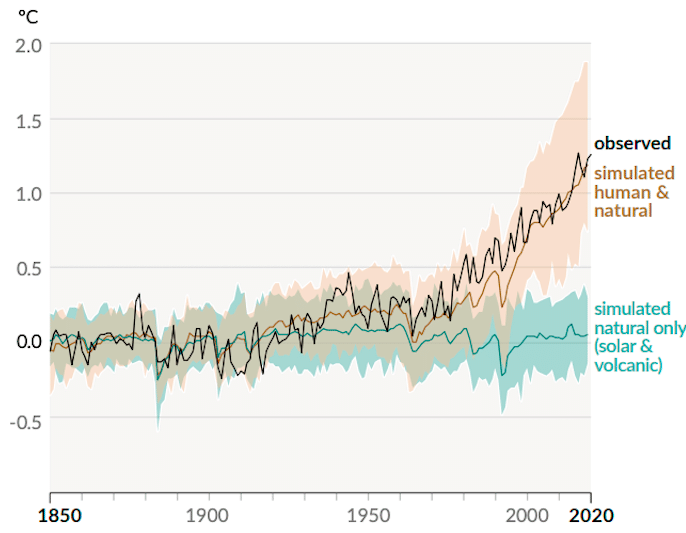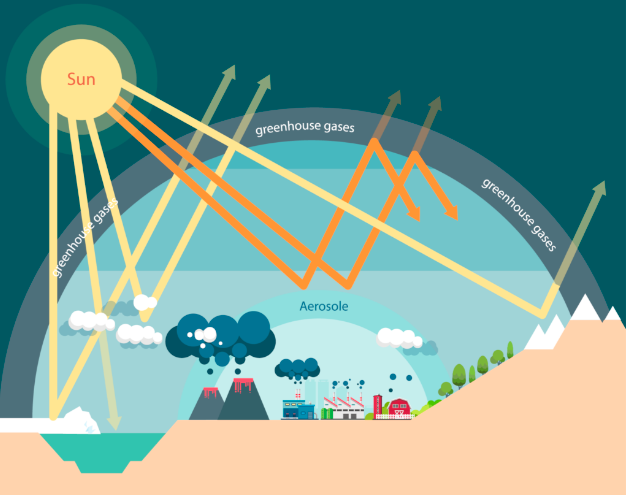Understanding Climate Change
The climate of our planet is influenced by several natural factors, such as major volcanic eruptions, ocean currents and variations in solar energy. However, human activities such as the use of fossil fuels, agriculture and industrial activities, etc, are causing an increase in the concentration of greenhouse gases in the atmosphere.
Ever since the industrial revolution, this cause of climate warming has been 50 times more powerful than natural phenomena, acting with record speed compared to the last 2000 years. Thus, despite the presence of natural factors that influence the climate, there would probably be no global warming currently if it were not for human activities, as demonstrated by the figure below, from the Intergovernmental Panel on Climate Change.
Change in global surface temperature (annual averages) observed and simulated using human and natural factors

Figure 1. Change in global surface temperature observed over the last 170 years (black line) compared to the period from 1850 to 1900. Temperature change simulated by including human and natural factors (brown line) and by including only natural factors like solar and volcanic activity (blue line). The lines in the centre of the brown and blue areas indicate the average of the simulations. Source: IPCC (2021).
What is climate change?
Climate change is defined as an alterations to average weather conditions, extremes, and to the variability that persists over a long period of time, typically for decades or more. Climate change is leading to a long-term increase in global temperatures and sea levels, as well as changes in the intensity and frequency of certain extreme events such as storms and forest fires.
Source : climatedata.ca
The greenhouse effect
The sun is Earth’s source of energy. It emits energy with short wavelengths—the sun’s rays. Some of the energy is reflected back into space by the Earth and the atmosphere (about 1/3). The rest reaches the Earth’s surface and heats it up. Excess heat that the Earth cannot absorb is reflected back in the form of infrared radiation, a long-wavelength type of energy.
However, greenhouse gases, which are naturally present in the atmosphere, act as a blanket and trap the heat returned by the Earth. They are very aptly named, because they act in the same way as garden greenhouses. Greenhouse gases (GHGs) come from natural sources and raise the average temperature at the Earth’s surface from about -16°C to +15°C. In this way, they maintain a temperature that is warm enough to support life on Earth. The best known greenhouse gas is carbon dioxide (CO2), because of its predominance in the atmosphere, but there are several others such as methane (CH4) and nitrous oxide (N2O).

Figure 2. Greenhouse effect
Source : climatedata.ca
However, since the beginning of the industrial age, GHG concentrations in the atmosphere have risen dramatically due to the use of fossil fuels such as oil, natural gas and coal. This increase, mainly in CO2, retains part of the energy returned by the Earth, which causes excessive warming of the climate. In other words, the “blanket” is getting thicker. This phenomenon is even more troubling because some of these gases have a long lifetime and will influence the climate for many years to come. Global warming is partly attenuated by the rise in atmospheric aerosols, which, in contrast, have a cooling effect on the climate. But this is not enough to cancel out the strong warming effect caused by GHGs.
The scientific consensus
Since 1988, the Intergovernmental Panel on Climate Change (IPCC) has been assessing the available scientific information related to climate change in an unbiased and methodical manner. This information is drawn from studies published in scientific journals by experts in the field. The IPCC also works to identify elements that are the subject of a consensus among the entire scientific community.
Summary reports on the results are regularly published. In 2021, the IPCC published a report stating unequivocally that human influence has warmed the atmosphere, ocean and land and that changes in extreme events such as heat waves, heavy precipitation and droughts can already be attributed to it.
The consensus extends to related sciences: cryosphere analysis, hydrology, oceanography, geography and many others. The analysis of the results published in scientific articles reveals that more than 99% of these researchers agree that the planet is warming and that humans are the cause.
What is natural climate variability?
The climate varies naturally on different time scales: by season, by year and by decade. Many of these variations are due to interactions between different components of the climate system such as the atmosphere, oceans, land and ice. Some phenomena occur cyclically. For example, the North Atlantic Oscillation manifests in cycles of about twenty years. This oscillation affects winter temperatures and precipitation as well as the depth of the snow on the ground in Quebec.
Major volcanic eruptions are more chaotic and can cool the climate over a few years. During a volcanic eruption, large amounts of particles spew into the atmosphere. These spread rapidly over the entire surface of the globe, influencing the climate at the same time.
These natural phenomena can influence the climate over several years or even decades. Thus, they decrease or amplify the trend of global warming over a long period of time. These fluctuations are misleading, so that is why it is important to use at least 30 years of climate data to distinguish between natural variability cycles and climate change.